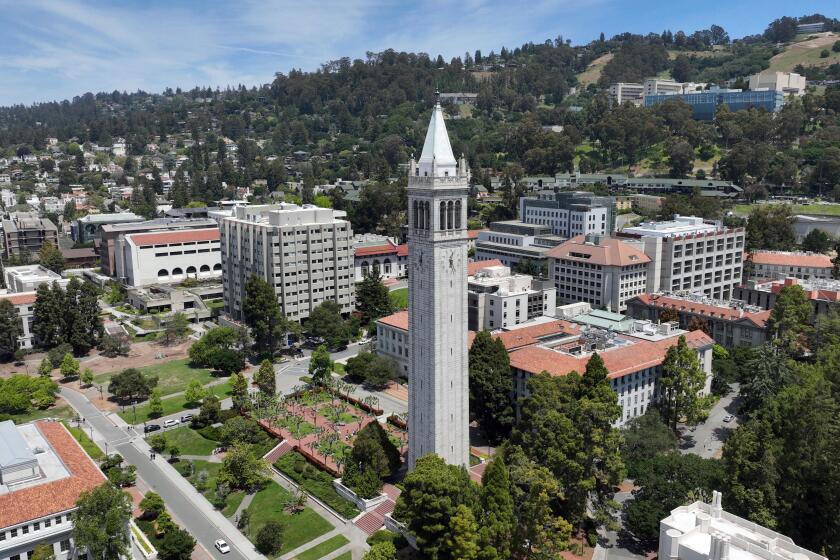Lawsuit accuses UC of illegally giving admissions preference to Black and Latino students

- Share via
- A federal lawsuit accuses UC of illegally considering race in admissions.
- It argues that UC admissions favor Black and Latino applicants and hurt white and Asian American ones.
- UC calls the allegations ‘meritless’ and says it follows the law.
A federal lawsuit accuses the University of California of illegally considering race when accepting new students, alleging that the system’s long-term growth of Black and Latino enrollment would not be possible under a state law prohibiting the use of race in admissions and a Supreme Court ruling that struck down affirmative action.
The lawsuit was filed Monday in California’s Central District federal court on behalf of Asian American and white students who are considering applying to UC campuses as first-year applicants, transfers or law students. It alleges that UC gives “discriminatory preferences to non-Asian racial minorities” in violation of Proposition 209, the Constitution’s equal protection clause and the Civil Rights Act of 1964, which says groups that receive federal funding cannot racially discriminate.
On Tuesday, a UC representative said officials had not been served with the suit.
A record number of Californians enrolled at UC in the fall while out-of-state and international students declined. Berkeley and UCLA bucked national trends at elite universities with increased Black and Latino enrollment.
“If served, we will vigorously defend our admission practices. We believe this to be a meritless suit that seeks to distract us from our mission to provide California students with a world class education,” the UC statement said.
“Since the consideration of race in admissions was banned in California in 1996, the University of California has adjusted its admissions practices to comply with the law. We stand by our admission policies and our record of expanding access for all qualified students. The UC undergraduate admissions application collects students’ race and ethnicity for statistical purposes only. This information is not shared with application reviewers and is not used for admission.”
Lawyers representing the plaintiff, Students Against Racial Discrimination, include those from America First Legal, which was founded by President Trump’s deputy chief of staff for policy, Stephen Miller. The group is also represented by Jonathan Mitchell, the former solicitor general of Texas.
UC, like all public educational institutions in the state, is barred from considering race in admissions under Proposition 209. The 1996 ban prompted a drop in admissions of Black and Latino students at UCLA and UC Berkeley — the two most competitive UC schools. Their admission numbers have rebounded over the years as the university developed more holistic admissions practices and outreach to college counselors, high schools and nonwhite communities.
The 2023 Supreme Court ruling overturning affirmative action led to sharp declines at dozens of elite universities in admissions of Black and Latino students. But UC has touted its campus-by-campus enrollment of nonwhite groups, which has remained roughly the same or has grown. UCLA has significantly boosted its Black and Latino student applications and enrollment after more than 25 years of targeted outreach.
President Trump signals plans to weaken the Department of Education, throwing into question the fate of financial aid and funding for underserved students.
Over the years, UC has moved from using an “academic index” based on test scores and GPA for admissions to a comprehensive review that considers 13 factors, including GPA, the rigor of coursework, talents and life experiences. Admissions directors stress that applicants are not compared with all others across the board but more directly with peers in their schools or similar socioeconomic circumstances. Most selective universities also use holistic review, including USC.
The lawsuit said UC’s holistic process moves away “from objective criteria towards more subjective assessments of the overall appeal of individual candidates.”
Students Against Racial Discrimination was formed last fall and is led by legal scholars including Richard Sander, a UCLA law professor and longtime opponent of affirmative action. It models itself after Students for Fair Admissions, the nonprofit that successfully won its suit at the Supreme Court against Harvard’s affirmative action program.
Though UC does not directly use racial data in admissions, Sander said in an interview that he believes the university employs “socioeconomic data,” such as information on racial demographics and income levels in geographic areas, as a proxy for race, and uses other measures in its holistic review of applicants that are akin to racial preferences.
“There is abundant evidence that underrepresented minorities benefited when the University of California was reasonably compliant with Prop. 209 during the first decade after Prop. 209’s passage. ... The university ignored this evidence and reintroduced illegal racial preferences during the late 2000s and 2010s to virtue-signal rather than to advance legitimate educational goals,” Sander alleged.
As much as $725 million will go to three fire-damaged campuses, under a broad ‘climate resiliency’ plan. Two smoke-damaged schools get a new safety evaluation.
Over the years, the number of UC applications has increased, resulting in lower admission rates for all in the competitive system. The lawsuit alleges UC campuses illegally use race in considering applications because admission rates for Black and Latino applicants have declined less than those for all students over time.
In 2010, UC Berkeley admitted 13% of Black Californians who applied compared with 21% of all Californian applicants, the lawsuit says. By 2023, that gap had narrowed; the admission rate for Black Californians was 10%, just 2% lower than the overall admission rate among Californians. The suit describes similar patterns at other campuses.
Although the lawsuit claims Asian Americans are harmed by UC admission practices, they have long had the highest admission rates among first-year Californians compared with other racial and ethnic groups systemwide. In fall 2024, UC admitted 76.6% of Asian American applicants compared with 68% of Latinos, 65% of whites and 60% of Black students.
Asian Americans also make up the largest proportion of UC undergraduates at 36.3%, even though they account for 19% of California high school graduates who met UC admission requirements. Asian Americans also had the highest admission rate at UC Berkeley, at 16.3%; at UCLA, their admission rate was 10.4%, compared with 10.6% for Black students.
The growth in Latinos admitted to UC campuses reflects at least in part the larger number of qualified applicants. The number of Latino graduates from California high schools who met UC admission requirements — a 3.0 GPA and completion of a series of college-preparatory classes with at least a C grade — grew to 108,145 in 2023-24 from 87,275 in 2016-17, according to state Department of Education data. The number of qualified Black graduates dipped slightly, to 8,998 from 9,174 during that same time period.
Trump’s executive order calling on campuses to address antisemitism has university leaders, faculty and students concerned as the president vows to revoke visas of pro-Palestinian international students who have taken part in protests.
The suit also asked for the university to be more forthcoming in the data it releases on its admission practices. UC compiles annual reports about admissions and enrollment, including gender, race, sexual orientation and other factors, and campuses also separately release information.
The suit alleges race-based admission practices at UC harm admitted “Hispanic and Black students who are often placed at a significant academic disadvantage, and thus experience worse outcomes, because of the university’s use of racial preferences.”
Sander elaborates on the theory in “Mismatch,” a book in which he argues that less-qualified racial minorities are put at a disadvantage when admitted to competitive colleges because they are up against more qualified students and fall behind.
Patricia Gándara, an education and admissions expert who is the director of the UCLA Civil Rights Project, said Sander’s arguments and the suit “simply do not add up.”
“UC has done an admirable job of figuring out how to not use race but to admit a diverse group of students. I really don’t think that these plaintiffs can prove that race is being used,” Gándara said.
She pointed out, by example, that more than half of high school graduates in California are Latino, yet they make up a significantly smaller portion of UC admissions.
“Just looking at the numbers themselves, it is nowhere close to proportionate,” Gándara said. “UC is clear about what it looks at, and that can include a variety of different kinds of diversity outside of race.”
Gándara also believes Sander’s “mismatch” theory is wrong.
“When students are placed in more demanding circumstances, those students rise to the occasion,” she said. “It is not being accepted to a more demanding university that leaves students behind.”
A record number of Californians enrolled at UC in the fall while out-of-state and international students declined. Berkeley and UCLA bucked national trends at elite universities with increased Black and Latino enrollment.
Edward Blum, the founder of the Students for Fair Admissions, said the California suit marked the next chapter in the legal fight over race in college admissions.
“The question is, if UC systems are saying they are not using racial preferences and classifications, what are they doing?” Blum said. “What has caused in their policies the slow but steady growth in underrepresented minorities at the more competitive UC schools? ... What are they using as a racial proxy or classification?”
UC’s fall 2024 enrollment data, released last month, showed year-to-year gains among several racial and ethnic groups. After Asian Americans, Latinos were the second-largest group, growing to represent 26.7% systemwide. White students were down slightly, to 19.8%. Black students made up 4.8% of enrollment — a slight increase — for a total of 11,257.
Mitchell, the former Texas solicitor general, said he planned to file lawsuits against additional universities but did not specify which ones.
“Universities continue to defy the law by using race and sex preferences in student admissions and faculty hiring,” Mitchell said. “We will keep suing them until they adopt colorblind admissions and rid themselves of every last vestige of these odious and discriminatory practices.”
More to Read
Sign up for Essential California
The most important California stories and recommendations in your inbox every morning.
You may occasionally receive promotional content from the Los Angeles Times.
















